
Eastern Chipmunk
Tamias striatus
Description
Eastern Chipmunks are small rodents with flat, hairy tails and fur ranging from gray to reddish-brown in color. They have five black stripes on the sides and back, with white bands between the stripes on the sides of the body. They have additional stripes around their eyes. Males and females are similar in appearance.
Size
An Eastern Chipmunk typically measures 11.5-18.6 cm
(4.5-7.3 inches) from the head to the base of the tail, which adds another 7-11 cm (2.75-4.3 inches). It weighs between 66 and 150 g (2.3-5.3 oz).
Adaptations
- A chipmunk’s cheek pouches can expand up to three times their normal size to allow the chipmunk to carry food.
- The bushy tail of a chipmunk helps it to keep its balance while climbing in trees.
Diet
Chipmunks typically consume fruits, seeds, and nuts, but have also been known to eat insects, earthworms, mushrooms, and eggs. At Cosley Zoo, Alvin is fed a prepared rodent diet supplemented by nuts, seeds, and produce.
Reproduction
Eastern Chipmunks are polygamous (each female will mate with several males). Females produce two litters per year (one in the spring and one mid-summer), with a 31-35 day gestation. Two to five young are typically born per litter. After caring for the young for 6 weeks, the female weans them. They become independent 2 to 4 weeks later.
Shelter and Space Needs
Eastern Chipmunks are found throughout the eastern United States and southeastern Canada. They prefer wooded areas with stumps and logs to provide cover. They can adjust well to living in areas inhabited by humans, and can also be found in suburban areas around houses and outbuildings.
Life Expectancy
A chipmunk typically lives less than two years in the wild. Individual animals have the ability to live up to 8 years.
Relationship with Man
Chipmunks play an important role in the ecosystem as a significant prey item for many predatory species, including foxes, bobcats, coyotes, owls, and raccoons. It is not common for chipmunks to become serious pests in homes or gardens. They can help to disperse plant feeds or mushroom spores when they feed.
Fun Facts
- While chipmunks hibernate in the winter, they do not sleep all the way through the winter season. They wake up every few days to eat and excrete waste.
- Although the Eastern Chipmunk is able to climb trees, it spends most of its time on the ground excavating complex systems of burrows.
- Chipmunks can perform a variety of vocalizations, which they use to defend their territory, warn each other of danger, and attract mates.





